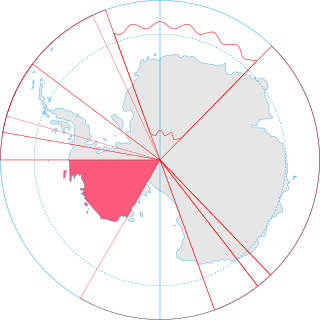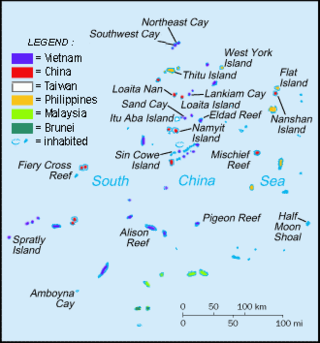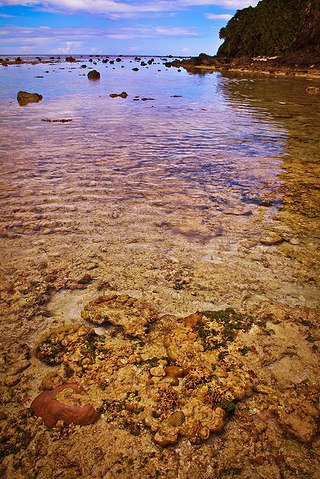
The Permanent Court of Arbitration (PCA) is a non-UN intergovernmental organization located in The Hague, Netherlands. Unlike a judicial court in the traditional sense, the PCA provides services of arbitral tribunal to resolve disputes that arise out of international agreements between member states, international organizations or private parties. The cases span a range of legal issues involving territorial and maritime boundaries, sovereignty, human rights, international investment, and international and regional trade. The PCA is constituted through two separate multilateral conventions with a combined membership of 122 states. It is not a United Nations agency, but a United Nations observer.

The Treaty of Peace between the United States of America and the Kingdom of Spain, commonly known as the Treaty of Paris of 1898, was signed by Spain and the United States on December 10, 1898, that ended the Spanish–American War. Under it, Spain relinquished all claim of sovereignty over and title to territories described there as the island of Porto Rico and other islands now under Spanish sovereignty in the West Indies, and the island of Guam in the Marianas or Ladrones, the archipelago known as the Philippine Islands, and comprehending the islands lying within the following line:, to the United States. The cession of the Philippines involved a compensation of $20 million from the United States to Spain.

Terra nullius is a Latin expression meaning "nobody's land". It was a principle sometimes used in international law to justify claims that territory may be acquired by a state's occupation of it. There are currently three territories sometimes claimed to be terra nullius: Bir Tawil, four pockets of land near the Danube due to the Croatia–Serbia border dispute, and parts of Antarctica, principally Marie Byrd Land.

Scarborough Shoal, also known as Bajo de Masinloc, Panatag Shoal, Huangyan Island, and Democracy Reef, are two rocks in an atoll administered by China in the South China Sea. It is located between Macclesfield Bank, a sunken atoll of underwater reefs and shoals east of the Paracel islands and Luzon, the nearest landmass, 220 kilometres (119 nmi) away and the largest island of the Philippines.

The North Borneo dispute, also known as the Sabah dispute, is the territorial dispute between Malaysia and the Philippines over much of the eastern part of the state of Sabah. Sabah was previously known as North Borneo prior to the formation of the Malaysian federation.
The Bering Sea Arbitration of 1893 arose out of a fishery dispute between the United Kingdom of Great Britain and Ireland and the United States in the 1880s. The United States Revenue Cutter Service, today known as the United States Coast Guard, captured several Canadian sealer vessels throughout the conflict. Diplomatic representations followed the capture of the first three ships and an order for release was issued by the British imperial government, but it did nothing to stop the seizures and none were released. This led to the U.S. claiming exclusive jurisdiction over the sealing industry in the Bering Sea, and that led to negotiations outside of the courts. The award was given in favor of the British, however, and the Americans were denied exclusive jurisdiction. The British were awarded compensation for the damage that had been inflicted on their vessels, and the American sealing zone remained as it was prior to the conflict.
Intertemporal law is a concept in the field of legal theory.

Guayana Esequiba, sometimes also called Esequibo or Essequibo, is a disputed territory of 159,500 km2 (61,600 sq mi) west of the Essequibo River that is administered and controlled by Guyana but claimed by Venezuela. The boundary dispute was inherited from the colonial powers and has been complicated by the independence of Guyana from the United Kingdom in 1966.

Arbitration is a form of alternative dispute resolution (ADR) that resolves disputes outside the judiciary courts. The dispute will be decided by one or more persons, which renders the 'arbitration award'. An arbitration decision or award is legally binding on both sides and enforceable in the courts, unless all parties stipulate that the arbitration process and decision are non-binding.
The Philippines has claimed many territories throughout its history. These territories include the Spratly Islands, portions of North Borneo, and the Scarborough Shoal.
The discovery doctrine, or doctrine of discovery, is a disputed interpretation of international law during the Age of Discovery, introduced into United States municipal law by the US Supreme Court Justice John Marshall in Johnson v. McIntosh (1823). In Marshall's formulation of the doctrine, discovery of territory previously unknown to Europeans gave the discovering nation title to that territory against all other European nations, and this title could be perfected by possession. A number of legal scholars have criticized Marshall's interpretation of the relevant international law. In recent decades, advocates for Indigenous rights have campaigned against the doctrine. In 2023, the Vatican formally repudiated the doctrine.
A number of methods of acquisition of sovereignty are or have been recognised by international law as lawful methods by which a state may acquire sovereignty over territory. International law adopts much of Roman property law in regards to acquisition of sovereignty due to the underlying European civil law at the time of early discovery voyages such as Christopher Columbus. The basis of acquisition of states ownership of vacant territory therefore continues to apply,.
The sovereignty of the Philippines refers to the status of the Philippines as an independent nation. This article covers sovereignty transitions relating to the Philippines, with particular emphasis on the passing of sovereignty from Spain to the United States in the Treaty of Paris (1898), signed on December 10, 1898 to end the Spanish–American War. US President William McKinley asserted the United States' sovereignty over the Philippines on December 21, 1898 through his Benevolent Assimilation Proclamation.
Investor-state dispute settlement (ISDS) or investment court system (ICS) is a system through which countries can be sued by foreign investors for certain state actions affecting foreign direct investment (FDI). This system most often takes the form of international arbitration between a foreign investor and the nation receiving the FDI.

The Manila Accord was signed on 31 July 1963 by the Federation of Malaya, the Republic of Indonesia and the Republic of the Philippines, after a meeting from 7 to 11 June 1963 in Manila.

The Spratly Islands dispute is an ongoing territorial dispute between China, the Philippines, Taiwan, Malaysia, Vietnam, and Brunei, concerning "ownership" of the Spratly Islands, a group of islands and associated "maritime features" located in the South China Sea. The dispute is characterized by diplomatic stalemate and the employment of military pressure techniques in the advancement of national territorial claims. All except Brunei occupy some of the maritime features.

The Venezuelan crisis of 1895 occurred over Venezuela's longstanding dispute with the United Kingdom of Great Britain and Ireland about the territory of Essequibo and Guayana Esequiba, which Britain claimed as part of British Guiana and Venezuela saw as Venezuelan territory. As the dispute became a crisis, the key issue became Britain's refusal to include in the proposed international arbitration the territory east of the "Schomburgk Line", which a surveyor had drawn half-a-century earlier as a boundary between Venezuela and the former Dutch territory ceded by the Dutch in the Anglo-Dutch Treaty of 1814, later part of British Guiana. The crisis ultimately saw Britain accept the United States' intervention in the dispute to force arbitration of the entire disputed territory, and tacitly accept the US right to intervene under the Monroe Doctrine. A tribunal convened in Paris in 1898 to decide the matter, and in 1899 awarded the bulk of the disputed territory to British Guiana.

Miangas or Palmas is North Sulawesi's northernmost island, and one of 92 officially listed outlying islands of Indonesia.

Philippines v. China, also known as the South China Sea Arbitration, was an arbitration case brought by the Republic of the Philippines against the People's Republic of China (PRC) under Annex VII of the United Nations Convention on the Law of the Sea concerning certain issues in the South China Sea, including the nine-dash line introduced by the mainland-based Republic of China since as early as 1947. A tribunal of arbitrators appointed the Permanent Court of Arbitration (PCA) as the registry for the proceedings.

The border between Indonesia and the Philippines consists of a maritime boundary mainly on the Celebes Sea that separates the two Southeast Asian countries as defined through a pact that was signed by both parties in 2014. The border is also the Exclusive Economic Zone (EEZ) boundary between Indonesia and the Philippines, which is delimited through eight geographic coordinate points. It has a length of 1,162.2 kilometres dividing across the Celebes Sea to the Philippine Sea.














